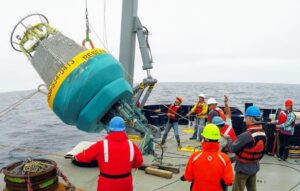MPA Monitoring Series: Ask the Researcher, Part 2: Ocean Observing Systems and Sandy Beach Ecosystems
June marked the second set of OPC’s “Ask the Researcher” MPA monitoring webinar series! In the 3rd and 4th webinars, we discussed Ocean Conditions Observing Systems and Sandy Beaches and Surf Zone Ecosystems. To learn more about this exciting summer series, and the first two webinars, check out: Ask the Researcher, Part 1: Kelp and Rocky Intertidal Ecosystems.
Ocean Conditions Observing Systems
The second webinar in the series began with a discussion on integrated ocean observing systems (PDF) with Dr. Henry Ruhl from the Monterey Bay Aquarium Research Institute. Dr. Ruhl started by introducing the California Integrated Ocean Observing System (CA IOOS), a regional partnership between the Central and Northern California Ocean Observing System (CeNCOOS) and the Southern California Coastal Ocean Observing System (SCCOOS). Using satellite data and other ocean observing technologies, the teams developed data products intended to help resource managers and members of the public better understand relationships between environmental factors and MPA performance.

Photo: James R. Wilkinson
The teams also developed an MPA Dashboard, which provides a snapshot of ocean physics, biogeochemistry, biology, and ecology across the statewide MPA network, and models future scenarios.
Notably, IOOS data dates back to 1988, creating a compilation of 32 years of data from 124 MPAs across California! The MPA Dashboard also provides detailed and accurate simulations of larval movement among MPAs.
Dr. Ruhl presented four main outcomes of the IOOS team’s MPA work:
- Simulations demonstrated strong connectivity between MPAs off the Monterey Peninsula.
- Frequency, persistence, and size of harmful algal blooms (HABs) have recently increased in areas with important migrating species.
- California MPAs provided more potential ‘climate refugia’ from 1980-2099 compared to overall state waters.
- All bioregions and MPAs will likely experience significant climate change by 2050.
The webinar concluded with Dr. Natalie Low of CeNCOOS giving a demonstration of the MPA Dashboard’s functionality.
Sandy Beaches and Surf Zone Ecosystems

Photo: David Hubbard
The sandy beaches and surf zone ecosystems (PDF) webinar was led by Dr. Jenny Dugan of UC Santa Barbara. These ecosystems make up roughly 75% of California’s open coast, but there was no long-term biological monitoring in beach ecosystems prior to this project. The dynamic nature of beaches makes them difficult to sample using traditional ecosystems surveying methods like quadrats or transects.
Monitoring took place on beaches across California from 2019 to 2020. The teams used 50-foot beach seines and Baited Remote Underwater Video (BRUV) cameras to survey surf zone fish in MPAs. Teams also collected data on kelp wrack cover and shorebird abundance on beaches as indirect MPA effects. Dr. Dugan shared the importance of sandy beach ecosystems and the four main results of this study:
- MPAs had positive effects on surf zone fish, showing increased species richness, abundance, biomass, and size.
- The strongest MPA effects were observed in Southern California beaches.
- Species richness and abundance of shorebirds is positively correlated with kelp wrack.
- Major declines in kelp forest and shorebird abundance were seen in several MPA and reference site beaches.
Further Exploration
You can read the full MPA monitoring reports for all of the MPA research projects on California Sea Grant’s website. Short on time? Check out the two-page snapshot summary reports available in both English and Spanish. All of the baseline and long-term monitoring data is available on the new California MPA data portal.
The next Ask the Researcher webinar will be on the California Collaborative Fisheries Research Program (CCFRP) on July 18, 2022 from 4:00 p.m. to 5:00 p.m. You won’t want to miss it! Join the webinar by Zoom.
View all of the post-webinar summaries on our blog or watch the webinar recordings on our YouTube channel

